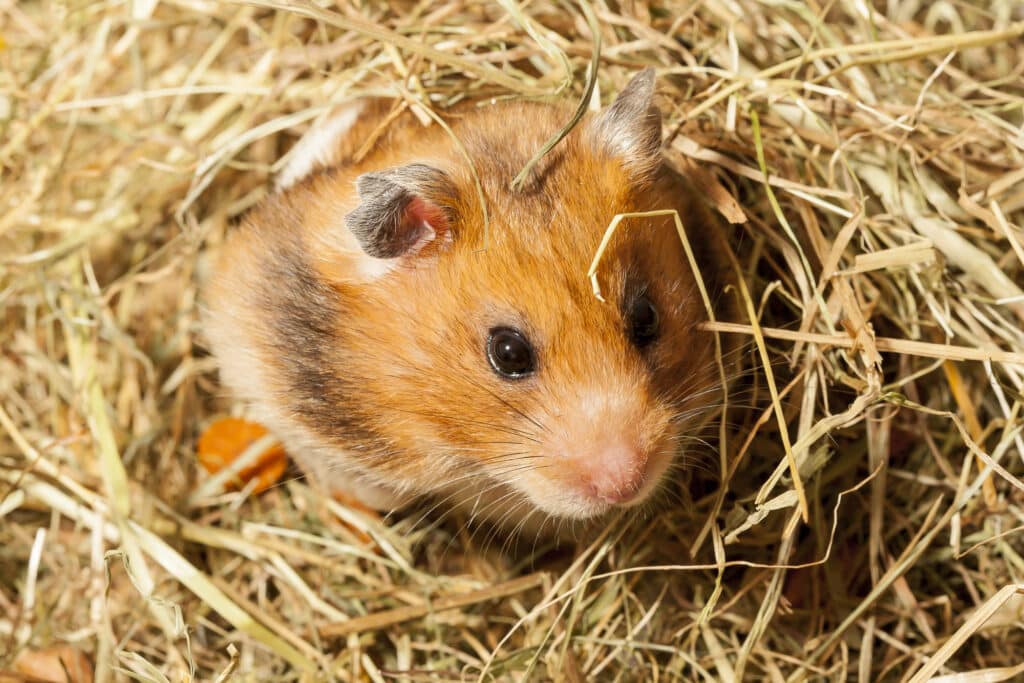When buying a hamster, you would have thought about all the good things he would bring into your life – Happiness, companionship, and that undeniable cuteness factor. In return, you would have sworn to take care of your hamster as best as possible. Yet, despite all your good intentions and best efforts, there is a chance that your hamster might try to escape his cage. If that happens, you may wonder, “Why is my hamster trying to escape? Am I not a good hamster parent? What am I doing wrong? How do I find a lost hamster?”
If that sounds like you, read this blog post to find out why your hamster is trying to escape and what you can do about it.
- Why is your hamster trying to escape?
- How can a hamster escape from his cage?
- What to do if your hamster has escaped? How to find a lost hamster?
Why is your hamster trying to escape?
1. Not enough cage space
Your hamster might try to escape if the cage is not big enough.
Hamsters are very active creatures. For example, Roborovski hamsters, the smallest but the most active pet species, run almost 6 miles in a single night in the wild. In human terms, that’s like running four marathons. Even though the other species of pet hamsters are not as active as Roborovski hamsters, you get the idea. Hamsters are extremely active. So, they need a cage that is big enough and contains different toys to simulate their activity in the wild.
But if your hamster cage is not big enough, your hamster might get bored and try to escape from the cage. Think about it this way. Wouldn’t you try to escape your house if it was too small and you had nothing to do all day long?
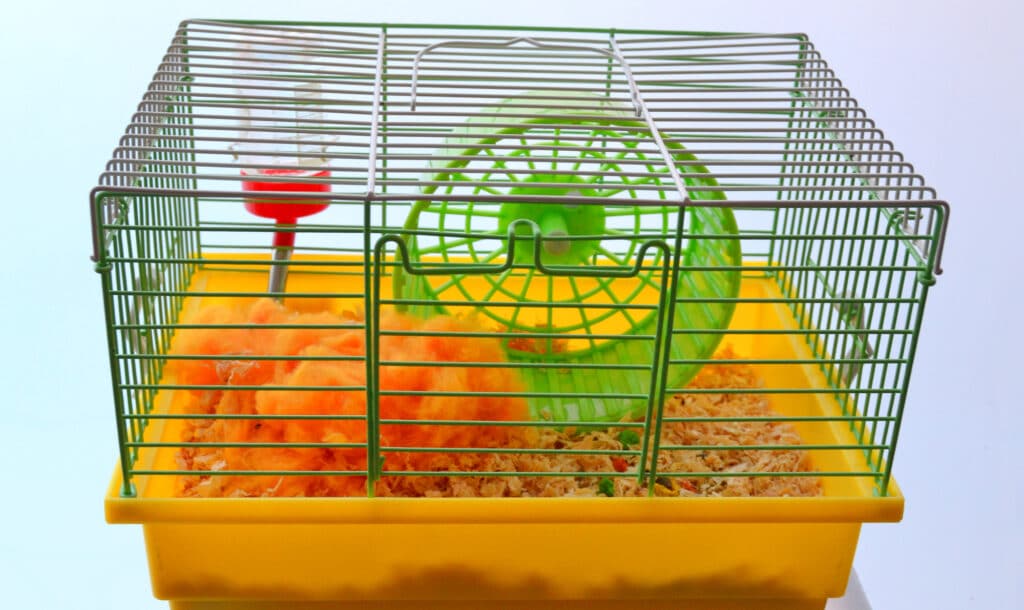
How to prevent your hamster from escaping due to insufficient cage space?
If your hamster is trying to escape because the cage is too small, you must get a larger cage. You should also have enough hamster toys in the cage for him to play with and a hamster wheel to run in. You can also use a hamster ball. This way, your hamster can run as much as he wants and explore your house without injuring himself.
Many hamster cages and associated accessories sold in pet shops are too small for Syrian hamsters. A Syrian hamster needs a cage at least 31 inches long, 20 inches broad, and 12 inches tall to be happy. Cages for gerbils and guinea pigs are actually more suited, in terms of size, for Syrian hamsters. A hamster wheel and hamster ball for a Syrian hamster should have a diameter of at least 12 inches. If not, they can cause back pain and lead to spinal curvatures, especially for younger Syrian hamsters.
Dwarf hamsters need a cage at least 24 inches long, 18 inches broad, and 12 inches tall. However, you should remember that dwarf hamsters are often housed in groups. So, it is also better for them to have a cage similar in size to the Syrian hamster cage discussed above. The hamster wheel and hamster ball for dwarf hamsters should also have a diameter of 12 inches. For more information, read the following blog posts: Campbell hamster, Chinese hamster, Winter White hamster, and Roborovski hamster.
2. Bored
Since a hamster’s cage should be able to simulate a natural environment, a hamster can get bored easily despite the cage being big if there aren’t enough toys to play with. A bored hamster will try to escape from the cage; a happy hamster wouldn’t.
So, to prevent your hamster from getting bored, buy hamster toys and a hamster wheel for your hamster to play with. The hamster cage should also contain sufficient bedding (6-inch deep bedding is preferable) to stimulate your hamster’s natural instinct for burrowing. Moreover, you have to play with your hamster every day. It will not only keep him from getting bored but also help you develop a deep bond with him.
If you need help choosing the right type of bedding for your hamster or are wondering how much bedding your hamster needs, the hamster burrowing guide can help you.
3. Stressed
Your hamster might also try to escape if he gets stressed too much and/or too often.
Hamsters are small prey creatures. They have terrible eyesight. But they are active during twilight hours when it is mostly dark. Moreover, they live in tunnels where it is always dark. So, they don’t need great eyesight anyway. But to make up for that, they have amazing senses of smell and hearing and an excellent ability to detect movements near them. These senses alert hamsters to the arrival of a predator and help them escape on time.
Pet hamsters do not face such life-death situations every day. But they still have excellent senses like their wild counterparts. So they will become alert to any noises and movements near them. Hence, loud sounds like a barking dog, a car sounding its horn, thunderstorm, crying babies, lawnmowers, and power tools can terrify hamsters. Do you want to find out how loud sounds affect hamsters? Read this blog post: Are hamsters sensitive to sound?
Hamsters can also get frightened if their cage is moved suddenly. Similarly, they can get scared if they are disturbed from their sleep. Likewise, if you have other pets, especially predator pets like cats or dogs, they can also stress your hamster out.
If your hamster gets terrified and does not find proper hiding places in his cage, he will try to escape.
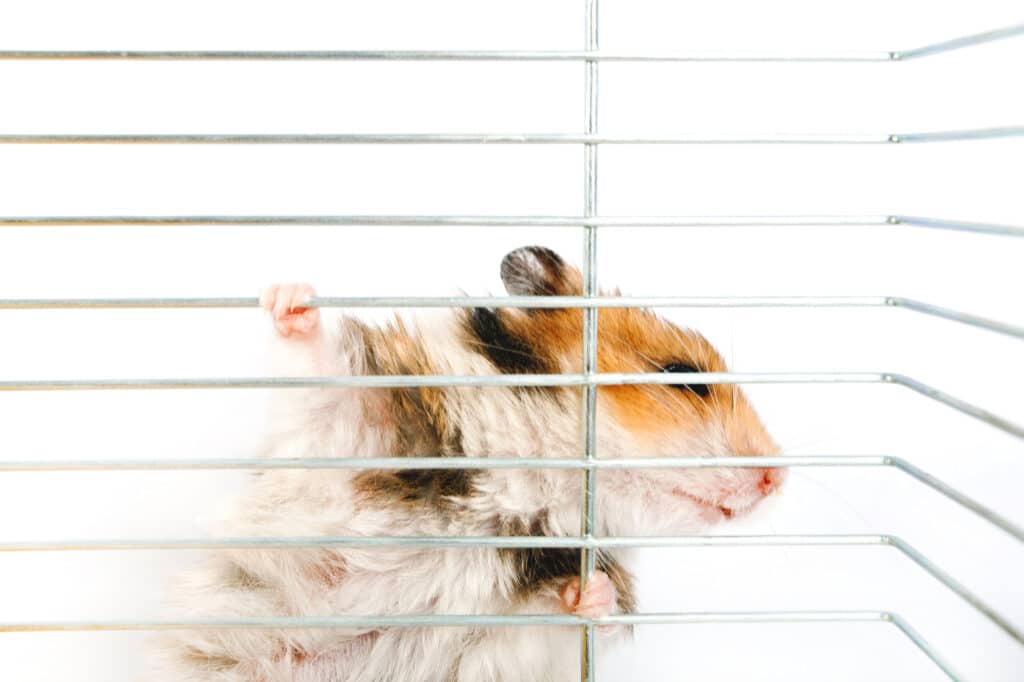
How to prevent a hamster from escaping due to stress?
If your hamster is trying to escape the cage due to stress, you have to provide a safe environment for him to live in. It is the duty of all hamster owners. To do that, identify the reason behind his stress and find a way to eliminate it.
- If the stress was caused by loud sounds, try placing your hamster cage in a room where these sounds aren’t that audible. If that’s not possible, try playing music to your hamster to mask the loud sounds. If you don’t know what music you should play for your hamster, read: Do hamsters like music?
- If your hamster is disturbed by sudden movements near his cage, be cautious when you are near your hamster’s cage. Walk slowly and don’t make sudden loud sounds.
- Regardless of how eager you want to play with your hamster, do not wake him up when he is sleeping. Wait until he wakes up before you hold him.
- If you have other pets, they will naturally be curious about your hamster and try to have a go at him. So, keep your hamster’s cage out of reach of other pets. If possible, keep the cage in a separate room that is not accessible to other pets.
4. Hungry
Hamsters have a fast metabolism. So, they need to eat every 2 hours when they are awake. If there isn’t sufficient food for your hamster inside the cage, he might try to escape the cage to forage for food. After all, foraging for food is the main reason why hamsters leave their burrows in the wild.
So, you need to keep enough food and fresh water for your hamster every day. Moreover, your hamster’s diet should include enough fresh food to add variety so that your hamster doesn’t get bored eating the same food every day. Need help creating the perfect hamster diet? Read the following blog posts:
What foods can hamsters not eat?
5. Not enough chew toys
Unlike a human’s teeth, a hamster’s teeth keep growing until he dies. So, he needs to wear them down consistently. For this purpose, a hamster needs something to chew on. Even though hard and fibrous food items, like hay, can help, a hamster chew toy available in pet stores is more suitable for this purpose. If there aren’t enough chew toys for your hamster to chew, he might try to escape the cage to find one.
So, keep enough chew toys for your hamster inside the cage.
6. Change of place
If you have just brought your hamster home from a pet shop or a pet shelter, your hamster will naturally be scared because of the new surroundings. Unfamiliar surroundings are one reason why your hamster might get defensive if you try to hold him and even try to escape from the cage.
So, give your hamster enough time to get used to the surroundings. Then, start taming your hamster using treats. If you have never owned a hamster before and need help with taming your hamster, this blog post can help you: How to tame your hamster?
Similarly, if you suddenly move your hamster’s cage to a new room, the surroundings might seem new to him. So, he might try to escape. Therefore, if you can help it, do not change the location of your hamster’s cage.
7. Curious
Even though hamsters are small prey creatures who can get scared and stressed quickly, they are also very curious. If you have a hamster, you will find that whenever you are around, he will try to poke his head out of his cage to find out what you are doing. He may not be able to see much but will try to listen to what you are doing.
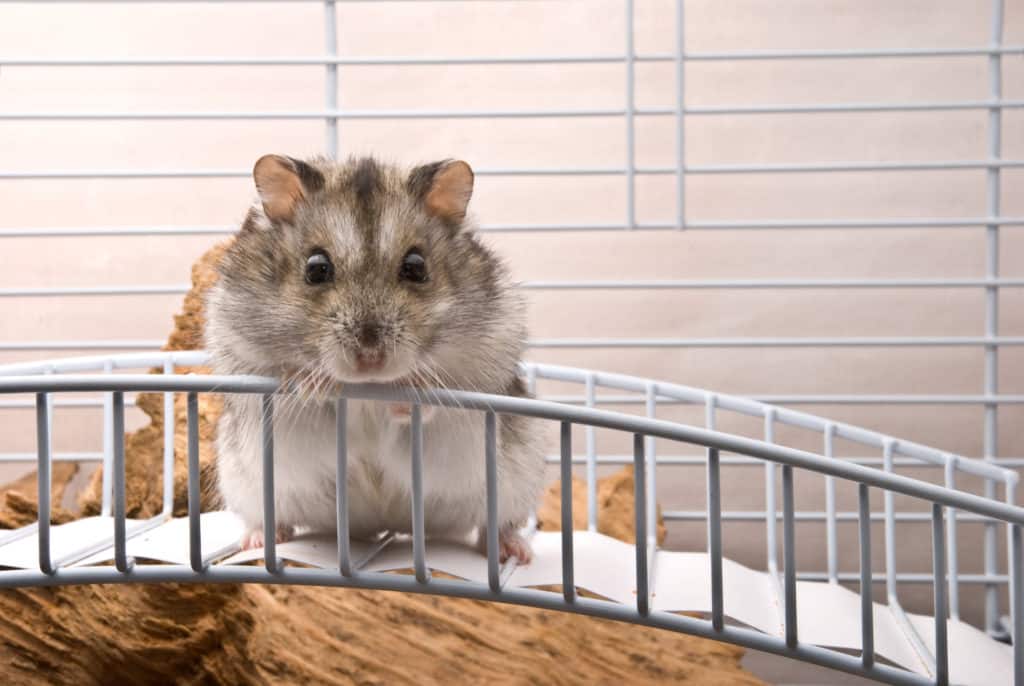
How to prevent a hamster from escaping due to curiosity?
If you find that your hamster is too curious, give him enough attention and play with him often. Give him some supervised time outside the cage. This can be a whole room or just a sofa.
If you decide to let your hamster explore the entire room, make sure that the room doesn’t have electrical wires (Your hamster might gnaw at it and get an electrical shock) lying around and is free of dust. A better choice would be a hamster ball since your hamster can run to his heart’s content while exploring the room and avoiding potential dangers. This will satisfy his curiosity a little bit. But be warned that not all hamsters may like hamster balls since it prevents them from interacting with the surroundings directly. Even if your hamster likes running inside the ball, you should only let him run a few minutes at a time.
You can also make a playpen for him and while he is playing, sit near him.
If your hamster tries to escape to get something that is outside the cage, keep a treat on the opposite side of the cage to distract him. Then, remove whatever he had his eyes on.
8. Untidy cage
Just like providing food and water to your hamster every day, you should also spot-clean the places where your hamster urinates and remove his feces every day. If not, over time, they can accumulate and create a pungent smell. While it may not disturb you that much, the pungent smell can be a deal breaker for hamsters because they have a strong sense of smell. So, they may try to escape the smell by escaping from the cage. A dirty cage is also detrimental to the health of your hamster.
Therefore, it is important that you clean your hamster’s cage regularly. Make sure that you take care of the other needs of your hamster as well.
9. Improper handling
Keeping hamsters as pets is not for the faint-hearted. Hamsters are delicate creatures. So, they must be handled carefully. If you squeeze them too much, they may not feel safe near you and feel threatened. If that happens, they may try to escape from your hands and even from the cage.

Hamsters, especially dwarf hamsters, are not suitable to be handled by children less than eight years old. Some dwarf hamsters should never be held because they are too small to be held in a hand and they aren’t as friendly as Syrian hamsters.
Even Syrian hamsters should not be forced to play if they are not in the mood to do so. Children should understand this and give these tiny creatures the space they need. If you are a parent who has young children, you should teach them to give hamsters some space.
10. Maybe, your hamster is not trying to escape
You have to understand that hamsters are highly active and naturally curious creatures. So, sometimes, the signs which indicate that your hamster is trying to escape the cage may not actually mean that your hamster is trying to escape. Maybe, he is being active and just doing normal hamster things.
For example, he might bite the metal bars of the cage to wear his teeth down and not to escape from the cage. So, you don’t have to worry, after all.
How can a hamster escape from his cage?
Until now, we saw the reasons for your hamster trying to escape from his cage. Now, let’s find out the different ways in which he might actually escape from the cage (Source: Hamster care). Once you know how your hamster can escape from his cage, you can take the necessary countermeasures to put an end to his escape attempts.
1. Squeezing through
Remember how I mentioned in an earlier section of this blog post that commercial hamster cages are too small for hamsters and that they need bigger cages, probably those sold for gerbils and guinea pigs? There is just one problem, though. The sides of these cages are often made with metal bars. The gap between these metal bars is normally big enough for even Syrian hamsters to get through.
As a general rule of thumb, if your hamster’s head can pass through the gap between the metal bars, his entire body will be able to pass through it. So, you have to be careful while buying a suitable cage for Syrian hamsters.
When it comes to dwarf hamsters, wire cages and cages with metal bars are not suitable because dwarf hamsters can easily pass through the gaps between the metal bars. So, you should instead buy glass tanks (like fish tanks) for dwarf hamsters.
2. Chewing
If you have cages made of cardboard, plastic, or wood, hamsters can easily chew through them, make a hole and get out. So, these cages are not at all suitable for hamsters.
3. Climbing through the top
Hamsters are amazing climbers. Even if the sides of your hamster cage are escape-proof, your hamster can still climb and escape through the roof of the cage if it is not secured. So you must properly secure the roof of the cage as well, if needed, with metal screws.
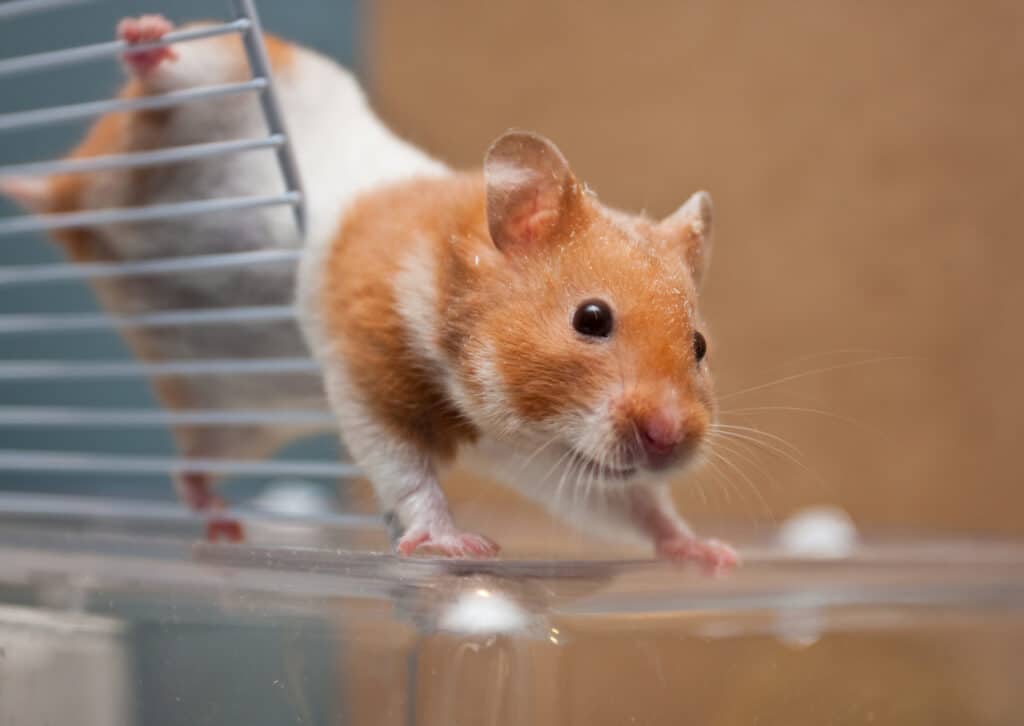
An important tip – Do not forget about the ventilation needed for your hamster while making sure that the cage is escape-proof.
4. Getting lost during playtime
In an earlier section of this blog post, I talked about how you can take your hamster outside of the cage and let him play in the room or on the sofa. While this is a great way to kill your hamster’s boredom, you should be vigilant at all times. If you take your eyes off your hamster because you want to reply to a message, check a photo on Instagram, or want to use the bathroom, your hamster can get lost.
If you have a playpen, it is not as dangerous. But you should make sure that the playpen is secured from all angles so that your hamster doesn’t escape the playpen and get lost by accident.
What to do if your hamster has escaped? How to find a lost hamster?
If you’ve taken all the measures mentioned above to keep your hamster safe, your hamster shouldn’t be able to escape his cage. But on the off-chance he does, how do you find him? Some of the below methods can help you find your lost hamster.
1. Search thoroughly
To make things easier in the worst-case scenario, always keep the door and windows of the room, where your hamster cage is, locked. That way, even if your hamster escapes his cage, you have to search only one room to find your lost hamster.
The first thing you should do once your hamster gets lost is search thoroughly. Search under the furniture, inside tables and drawers, blankets, clothes, bedding, utensils, etc. If you are lucky, you will find your lost hamster in one of these places.
2. Call out to your hamster
Sometimes a hamster can get lost and may not know how to return to his cage. If that’s the case, to find your lost hamster, call out to him. If you have tamed your hamster, your hamster should be able to recognize and associate your voice with playtime or treats. So, once your hamster hears your voice, he might come running to you.
3. Entice using treats
This is something that works most of the time. Hamsters are creatures that cannot say no to their favorite treats. So, if your hamster gets lost, entice him to come back to your hands by using his favorite treat.

4. Play his favorite music
If you have already trained your hamster to listen to music, play his favorite music. He might be tempted to come out of hiding to listen to the music.
5. Track his movements
Another way to find a lost hamster is to sprinkle some flour on the floor so that it creates a thin white layer across the floor. When your hamster comes out, which he will eventually do once he gets hungry, he will leave his footprints on the floor, thus making it easy for you to track his movements.
Alternatively, you can also spread aluminum foil across the floor so that when your hamster comes out, you can hear him. Then, you can have a shot at catching him (Source: Hamster Answers).
6. Use a trap to find your lost hamster
If you have tried searching for your hamster and still cannot find him, there is one more way to find your lost hamster. Create a trap to catch him. Don’t get me wrong, I am not talking about a mouse trap, though it would work too. Instead, you can create a trap by yourself.
For this, take a bucket and cover its top using a blanket in such a way that if your hamster stands on it, the blanket will fall to the bottom without hurting your hamster. Now place a treat over the blanket. Finally, arrange some boxes on the side of the bucket so that your hamster can climb to the top of the bucket.
Once everything is set up, wait for your hamster to take the bait. Check regularly to see if your hamster is inside the bucket.
In this blog post, I listed the reasons why your hamster is trying to escape and how to prevent it. I also listed some tips on how to find a lost hamster. If there is anything I missed, please let me know in the comments below.
